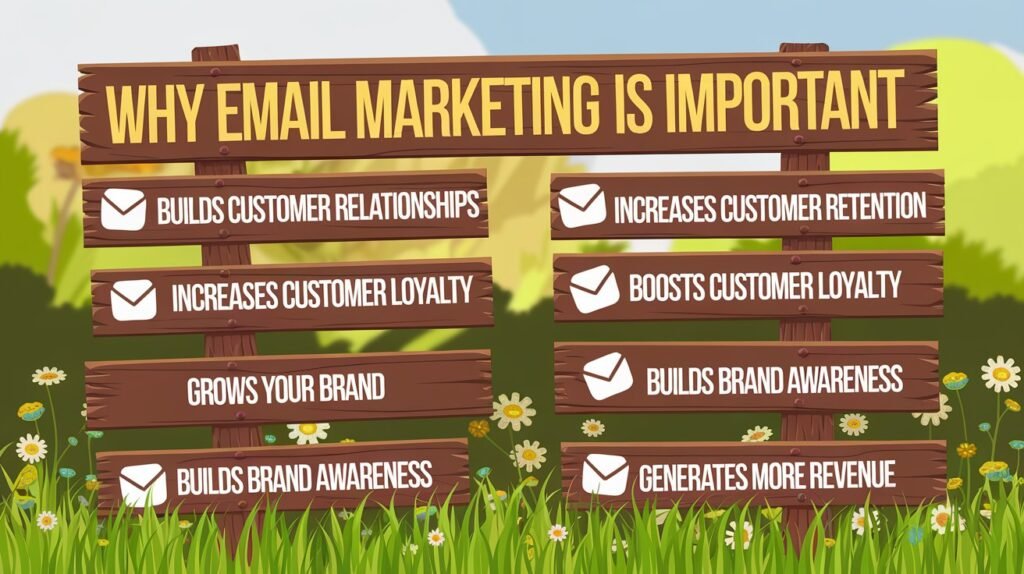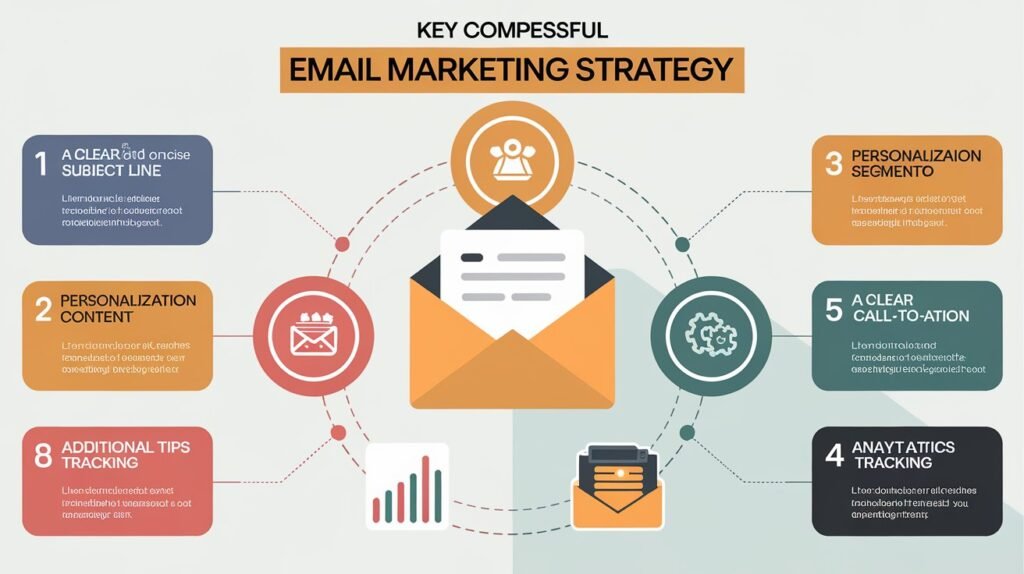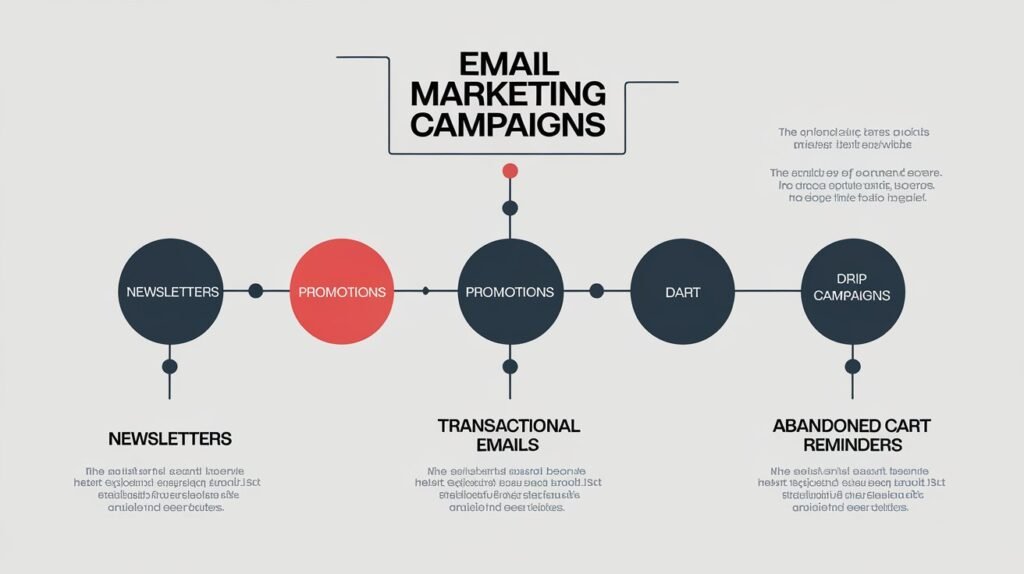Email marketing is the use of email to promote products or services while developing relationships with potential customers. It involves sending emails to a segmented audience with the aim of encouraging them to take specific actions, whether it’s making a purchase, signing up for an event, or engaging with content.
Email marketing remains one of the most powerful tools for businesses to connect with their audience, nurture relationships, and drive conversions. With a well-crafted email marketing strategy, companies can build brand loyalty, deliver personalized content, and achieve their marketing goals efficiently.
- Why Email Marketing is Important
- Direct Communication with AudienceEmail marketing offers a direct line of communication between your business and your target audience. This allows you to deliver tailored messages, promotions, or updates directly to your customer’s inbox, ensuring higher visibility.
- Cost-Effective MarketingCompared to other marketing channels like social media or paid ads, email marketing is incredibly cost-effective. It doesn’t require large budgets, making it accessible to businesses of all sizes.
- Personalized MessagingWith email marketing, you can segment your audience based on their interests, behaviors, or demographics. This ensures that the right message is delivered to the right person, increasing engagement rates.
- Measurable ResultsTools like open rates, click-through rates (CTR), and conversions provide valuable data to analyze and refine your email marketing campaigns, ensuring continuous improvement and optimization.
- High Return on Investment (ROI)According to research, email marketing can deliver an ROI of $42 for every $1 spent, making it one of the most lucrative marketing channels available today.

- Key Components of a Successful Email Marketing Strategy
- Building a Quality Email ListStart by gathering a list of email addresses from customers who have opted in to receive communications. This can be done through sign-up forms, lead magnets (like free ebooks or discounts), or during the checkout process.
- Segmenting Your AudienceSegmenting allows you to group your email list into smaller, more targeted audiences. You can segment based on factors such as demographics, previous purchase behavior, or engagement levels.
- Crafting Engaging Email ContentContent is king in email marketing. Ensure that your emails are valuable to your readers. The content should be relevant, engaging, and aligned with your audience’s interests and pain points.
- Designing for MobileOver half of all emails are opened on mobile devices, so it’s crucial to ensure that your emails are mobile-responsive. This means optimizing your emails for smaller screens, including clear calls-to-action (CTAs), and ensuring quick load times.
- A/B TestingTo improve the effectiveness of your campaigns, continuously test different elements of your emails. Test subject lines, email copy, visuals, CTAs, and sending times to discover what resonates best with your audience.
- Automating Email CampaignsEmail automation can help you nurture leads, onboard new customers, and retain existing ones. Automated workflows, such as welcome series, abandoned cart reminders, and post-purchase follow-ups, can improve customer engagement and retention.

- Common Types of Email Marketing Campaigns
- Welcome EmailsSent to new subscribers to introduce them to your brand and encourage them to take their first action (e.g., making a purchase or exploring content).
- Promotional EmailsHighlight special offers, discounts, or upcoming sales events to encourage immediate action.
- Newsletter EmailsProvide regular updates about your brand, including new blog posts, company news, and product launches.
- Transactional EmailsSent after a customer makes a purchase, these include order confirmations, shipping updates, and receipts. They are a great opportunity to upsell or cross-sell products.
- Re-engagement EmailsTarget inactive subscribers and encourage them to engage with your brand again, perhaps by offering a special discount or a reminder of the benefits of staying connected.

FAQ’s
1. What is the average ROI for email marketing?
The average return on investment for email marketing is $42 for every $1 spent, making it one of the highest ROI marketing channels.
2. How often should I send marketing emails?
The frequency depends on your business and audience. For many businesses, sending emails once a week is ideal, but this can vary based on engagement levels and the type of content you’re sharing.
3. What are the best tools for email marketing?
Some popular email marketing tools include Mailchimp, ConvertKit, SendinBlue, and ActiveCampaign. These platforms allow you to manage your email list, create templates, automate campaigns, and track performance.
4. How do I avoid my emails ending up in the spam folder?
To avoid the spam folder, make sure your email content is relevant, avoid excessive use of promotional language, and always get permission from your audience before emailing them. It’s also essential to include an unsubscribe option.
5. What is an open rate?
The open rate is the percentage of recipients who open your email. A good open rate typically ranges between 15% to 25%, but this can vary depending on the industry and the quality of your list.
6. What is email segmentation?
Email segmentation is the process of dividing your email list into smaller groups based on specific criteria, such as location, purchase history, or behavior. This allows you to send more personalized and relevant emails to each group.
7. What should I include in my email subject line?
A compelling subject line should be concise, engaging, and give a clear idea of what the email is about. Personalization, urgency, or highlighting a benefit often increases open rates.
8. How can I measure the success of my email campaigns?
Success can be measured through various metrics, including open rates, click-through rates, conversion rates, and overall ROI. Many email marketing platforms provide detailed analytics to track these KPIs.

